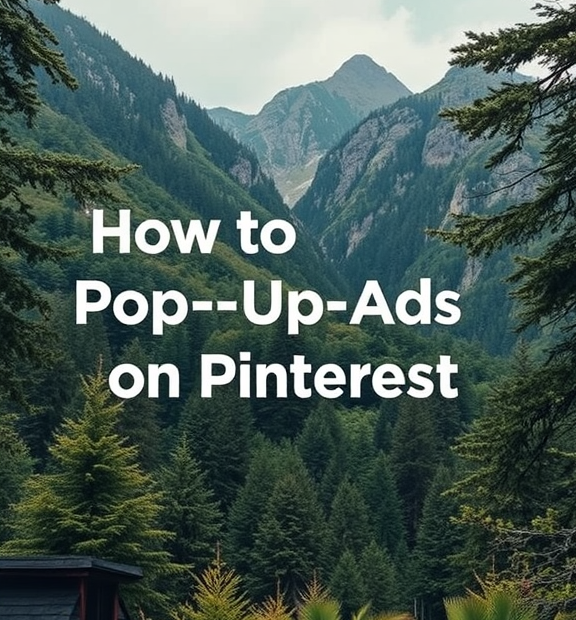Effective Techniques to Stop Pop-Up Ads on Pinterest for Good
Are you tired of pesky pop-up ads interrupting your browsing experience on Pinterest? These ads can be annoying and distracting, making it hard for you to focus on your creative projects. Thankfully, there are effective techniques to stop pop-up ads on Pinterest for good. Let’s dive into some straightforward strategies that can help you regain control over your Pinterest experience.
First, it’s essential to understand that many ads are personalized based on your online behavior. Here’s how you can tackle the issue:
Adjust Your Pinterest Settings
One of the first steps you should take is to review and adjust your Pinterest settings. Following these steps can help minimize unwanted ads:
- Go to your account settings: Click on your profile picture, then select “Settings” from the dropdown menu.
- Manage your ad preferences: Look for the section labeled “Privacy and Data.” Here, you can find options related to personalization and ad targeting.
- Turn off personalized ads: Disabling this option can significantly reduce the number of ads suitable to your interests.
By regulating what Pinterest knows about you, you can effectively limit the flow of pop-up ads.
Use an Ad Blocker
Ad blockers are powerful tools that can automatically remove unwanted ads from your browsing experience. Here’s how to use one:
- Choose an ad blocker: Popular choices include AdBlock, uBlock Origin, and AdGuard. Look for a blocker that suits your needs.
- Install the extension: Follow the instructions provided on the ad blocker’s website to install the extension in your web browser.
- Customize settings: Most ad blockers allow you to customize their settings to enhance your experience further. You can whitelist Pinterest for specific features while blocking pop-ups.
With an ad blocker, you can enjoy a clean browsing environment free from distractions.
Clear Your Cache and Cookies
Over time, cached data and cookies can build up, affecting how ads are displayed. By regularly clearing them, you can ensure a smoother experience. Here’s how:
- Open your browser settings: Navigate to the section where privacy settings are configured.
- Find cache and cookies: Look for options that allow you to clear cached images, files, and cookies.
- Clear data: Confirm your choices and clear the data to reset your browsing experience.
Love what I do? Be a hero and help me keep creating awesome content!
Support My Mission Now!Every donation fuels more great stuff – thank you, legend!
This simple action can not only reduce unwanted pop-ups but also enhance your browser’s performance.
Switch Browsers or Use a Privacy-Focused Browser
If pop-up ads continue to be a challenge on Pinterest, consider trying a different web browser or opting for a privacy-focused one. Browsers like Brave and Mozilla Firefox offer built-in features to block trackers and ads. Here’s what to do:
- Download a new browser: Ensure you download from a trustworthy site.
- Set it as your default: Move your Pinterest activity over to the new browser.
- Explore privacy settings: Take time to understand and tweak privacy settings that can further limit pop-up ads.
Love what I do? Be a hero and help me keep creating awesome content!
Support My Mission Now!Every donation fuels more great stuff – thank you, legend!
Switching browsers might be the breath of fresh air you need to create a better experience on Pinterest.
Report Annoying Ads
Pinterest gives you the option to report ads that you find troublesome. If you continually see specific pop-ups that annoy you, follow these steps to report them:
- Click on the three-dot menu: This option usually appears beside the ad.
- Select “Report ad”: Choose this option to provide feedback on what kind of problem you’re facing.
By reporting ads, you help Pinterest improve its advertising strategy, which could lead to a better experience for all users in the long run.
Love what I do? Be a hero and help me keep creating awesome content!
Support My Mission Now!Every donation fuels more great stuff – thank you, legend!
Implementing these strategies can significantly reduce pop-up ads on Pinterest, making your browsing experience much more enjoyable. Take control of your Pinterest browsing today, and watch as the distractions fade away!
Understanding the Impact of Pop-Up Ads on User Experience and Engagement
Pop-up ads have become a common part of online browsing, and their impact on user experience and engagement is significant. Many users find pop-ups annoying, and this frustration can lead to a decrease in the time they spend on a website. Understanding the effects of these intrusive ads can help you improve your web presence and retain users more effectively.
How Pop-Up Ads Disrupt User Experience
Love what I do? Be a hero and help me keep creating awesome content!
Support My Mission Now!Every donation fuels more great stuff – thank you, legend!
When visitors land on your site, a seamless experience is key to keeping them engaged. Unfortunately, here’s how pop-up ads disrupt that flow:
- Interruptions: Pop-ups often appear suddenly, interrupting the user’s reading or navigation experience. This can lead to frustration and can cause users to leave your site entirely.
- Distraction: Users are generally drawn to the content they came for. When pop-up ads are in their way, it diverts their attention, making it hard to focus on what matters.
- Annoyance: Repetitive pop-ups, especially those that don’t seem relevant, can aggravate users. This annoyance can significantly reduce the likelihood of return visits.
The Impact on User Engagement
A positive user experience is directly linked to user engagement. The presence of pop-up ads can influence this relationship in several ways:
- Bounce Rate: High bounce rates are a common consequence of pop-ups. When users are met with an ad before they can explore your content, they are likely to exit the site, increasing your bounce rate.
- Time on Site: If users are constantly closing pop-ups, their time on your site decreases. This means they might miss out on valuable content and offers that could keep them engaged.
- Brand Perception: Frequent pop-ups can tarnish your brand’s image. Users may perceive your site as spammy or untrustworthy, which can deter potential customers from returning.
- Conversion Rates: While pop-ups can sometimes be effective for conversions, their negative impact on user experience can counteract any benefits. Users might abandon their carts or get frustrated long before completing a purchase.
Strategies to Minimize Pop-Up Disruptions
To strike a balance between advertising and user experience, consider these strategies:
- Timing Matters: Instead of showing a pop-up immediately, set a delay. Allow users to browse your site for a few seconds before presenting an ad, enhancing the likelihood that they will engage positively.
- Reduce Frequency: Limit how often pop-ups appear. Showing them sporadically can prevent users from being overwhelmed and keep them coming back.
- Relevance is Key: Ensure that your pop-up ads are relevant to what users are viewing. Targeted ads enhance user experience by providing content that aligns with visitors’ interests.
- Use Exit Intent: Consider implementing exit-intent pop-ups, which only trigger as a user is about to leave your site. This approach captures attention without disrupting the browsing experience.
Alternatives to Pop-Up Ads
To enhance user experience without relying heavily on pop-ups, explore these alternatives:
- Inline Ads: Place advertisements within the content flow. This method reduces interruptions and maintains readers’ focus.
- Notification Bars: Use unobtrusive bars at the top or bottom of the screen to share promotions or important messages without disturbing users.
- Interactive Content: Engage users with interactive content like quizzes or surveys, which can attract attention without being intrusive.
Monitoring User Feedback
Always listen to user feedback regarding their experience with your ads. This can provide invaluable insights into how your audience feels about pop-ups and similar features on your site. Regularly monitor metrics such as bounce rate, time on site, and user feedback to make informed adjustments to your advertising strategies.
By understanding how pop-up ads affect user experience and engagement, you can create a more enjoyable online environment for your visitors. Adopting strategies that prioritize user experience will not only enhance visitor satisfaction but also improve overall engagement and conversion rates.
Conclusion
Taking control of your Pinterest experience is essential, especially when dealing with disruptive pop-up ads. By utilizing effective techniques such as adjusting your ad preferences, employing browser extensions, and regularly updating your privacy settings, you can significantly reduce, if not eliminate, these annoying interruptions. Each method is designed to give you the power to curate what you see while browsing, allowing for a smoother and more enjoyable time on the platform.
Understanding the impact of pop-up ads on user experience and engagement can help underscore the importance of these strategies. Pop-up ads can be frustrating, diminishing your overall enjoyment and potentially leading to disengagement from the platform. They can distract you from your creative inspiration and limit the effectiveness of Pinterest as a tool for discovery and planning. By addressing this issue, you not only enhance your own experience but also contribute to a larger community of users who value a clean and focused browsing environment.
Ultimately, by taking proactive steps and remaining informed about your options, you can enjoy an uninterrupted, seamless experience on Pinterest. This not only boosts your own engagement but also enriches the community of content creators and pinners alike. With these techniques in hand, you’re well-equipped to reclaim your space on Pinterest, allowing you to focus on what truly matters: discovering and sharing your favorite ideas and inspirations.

